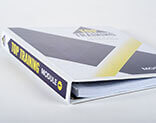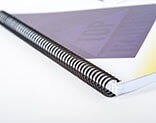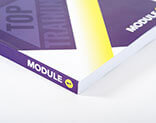As an experienced trainer, you’ll appreciate the value of providing your delegates with training manuals or workbooks.
But at the end of your training event, is that it? Do your delegates walk away, some leaving the manual, others taking them home to gather dust on a shelf? If so, you’re missing an opportunity.
You need your manual to be more – a valued resource which will be referred to regularly – and ultimately as a sales and marketing tool for your business or organisation. But for this to happen you need to make people want to keep using it.
Here are five ways to keep your manual in front of your delegate:
1. Be authentic. Be bold. Be different.
Your manual should be an extension of your training style, your personality and the relationship you want to promote with your delegates.
Don’t be afraid to be yourself. It’s easy to forget you’re still speaking to people when writing and presenting a training manual. Be genuine and project yourself – your personality will shine through.
2. Specialise and offer a resource
You’re the expert, and your manual is the perfect place to emphasise your skill set. Use your manual to showcase your knowledge and ability. Don’t hold back on offering information – remember you’re the one with the expertise and the more you offer, the more you’ll get back in loyalty and valuable referrals to new clients.
This is a great way to get your brand in front of other interested parties.
3. Longevity and interaction
A current ‘buzzword’ in training, marketing and sales is “engagement”. Getting some delegates to actively take part in your training sessions can sometimes be a struggle – a good manual can encourage engagement during and after the training event.
Challenge your people, ask them questions and leave them with things to think about so they will need to refer back to your courseware. Have actionable points which can be followed up on at a later date either online or in person.
4. Design and usability
Remember not to overwhelm your reader with huge blocks of text. Break the information down into bite-size chunks with regular summaries or ‘takeaways’.
Make use of ‘white space’. Allow reasonably sized gaps between content allows time for mental digestion and reflection. Don’t overwhelm your delegate by clumping everything together.
Structure your entire manual in an easy to use format. Use traditional navigation methods such as contents, index, chapters, sections, subsections, exercises and quizzes. Make it easy – even fun – to use.
5. Choose a suitable binding method
The way in which your manual is bound should be dictated by the overall purpose you are supplying the manual for.
A wire-bound manual allows the manual to be fully opened on a table to work from. This is especially useful when working at a computer or working in the manual itself.
A perfect-bound or “paperback” style will give a more “published” appearance and with its printed spine will stand out on a shelf. .

Another option is the ring binder which can be useful if you plan to update your training manual with additional modules.
Pages can be added and removed easily. this option provides flexibility.
Tabs and dividers (which can be custom-printed), and storage pockets for additional pages can help you make the manual easier to navigate.
Bear these points in mind and your manual should be more than just a rarely consulted reference guide. It will be a regularly referred-to resource and should act as a marketing and sales tool long after your training session has finished.
Most of our customers use wire-bound books and these are our biggest selling product. They are economical and practical in use. Wire-bound books lie flat on a desk in a training situation and so the page in use is kept easily. And in the workplace, should the content need to be referred to, the book can be easily folded back on itself and held in one hand. Saddle-stitched (i.e. stapled books) are neat for storage but do not remain as flat when opened and this effect increases the thicker they become.
Alternatives to wire-bound books are:
Coil-bound: these are bound in the same way with holes punched along the spine but use a spiral, plastic binding which is formed from a continuous length of plastic. Coil-bound books may be preferred in situations where metal should be avoided. They also make the pages slightly more secure in the book. This type of book costs a little more than wire-bound books.
Ring-bound manuals (ring-binders): these are ideal for modular courses where sections are to be added at intervals. They also allow for pages to be interchanged as the content is updated. Tabbed dividers can be added and we can print titles on the tabs or face of the divider. Though this is a more expensive option it is very versatile.
Design of courseware can be a time-consuming exercise for the busy training professional. It is important to distinguish between production of content (in which the trainer is the expert) and optimisation of the appearance.
There are many tools and facilities, such as Microsoft Office, that can help to give the best appearance to your text and images but an experienced graphic designer will usually add that something extra to your “mission critical” hand-out materials. Our team have access to professional grade software and image libraries which can be used along with their skills to maximise the visual impact and teaching value of your content.
We can review your existing course materials and offer suggestions on how they can be visually enhanced. You may have a Powerpoint presentation, an existing course manual or maybe a set of loose hand-outs. Send them to us and we can make suggestions as to how they might be further developed. We will often produce a free-of-charge re-design of a few sample pages for a client to show how your training materials would look after a complete re-work.
The old adage states that, “there is only one chance to make a first impression”. Your printed training materials say a lot about you and how you organise your work. You work long and hard to get the information just right. We can help you with that last step so that the look and presentation does justice to your efforts.
How much time do you spend producing and/or checking and packing your own training course materials? There is another way - a way that gives you back your time to spend on what you are good at - developing, marketing and delivering your training.
Read more


